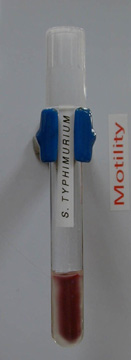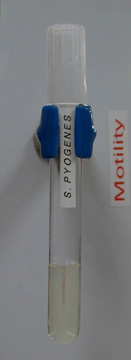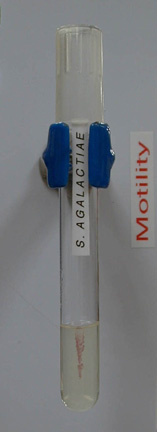Motility
In our lab, the preferred way to determine motility is to use the semi-solid medium which contains the indicator tetrazolium chloride (TTC).
Instructions on how to perform the test are here.
Reading a motility test is easy when you know what you're looking for.
When you're ready to read your inoculated tube, carefully hold it up to the light. It helps to hold an uninoculated tube next to it for comparison.
Is the inoculated tube cloudy at all? Is it more pink? Or is there a pink streak (the stab line) with crisp edges?
If the needle didn't go straight in and out, the stab line may not be a simple up-and-down line. If the needle was bent or your hand shook, the needle may have cut through the agar. Typically, though, such a cut only happens in one direction. If the growth of your organism spreads out in only one direction, and if there is a sharply differentiated edge between this growth and the agar, your organism is nonmotile. It has spread side-to-side only because those are places where the needle contacted the agar; in other words, the organism only grew where it was inoculated.
If the growth around the stab line has radiated outwards in all directions (it will often look fuzzy) or if the entire tube has turned pink, your organism is motile.
 |
 |
||||
S. typhimurium is motile; see the fuzzy pink color which
is radiating out from the stab line? |
S. pyogenes is non-motile. See how there is only pink growth along the stab line? | ||||
 |
How would you read a tube that looked like this? |
